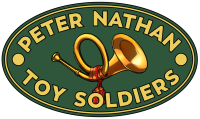21st Aug 2023
John Jenkins Designs Preview: New Kingdom Egyptians
The New Kingdom, is the period in ancient Egyptian history between the sixteenth century BC and the eleventh century BC. It was Egypt’s most prosperous time and marked the peak of its power.
It is also known as the “Ramesside period”, named after the eleven pharaohs who took the name Ramesses, after Ramesses I, the founder of the nineteenth Dynasty.

Infantry were armed as spearmen, mace/axe men, and khepesh men who were known as Nakhtu-Aa which literally translates as Strong Arms.
They usually carried a four to five foot spear, which was thrown just before engagement in hand to hand combat. Thrusting spears were not adopted until much later around the 7th Century BC.

One of the weapons carried by the infantry was the bronze Khopesh, which by this period had become quite large, and very formidable.
A distinguishing feature of infantry of this period which sets them apart from the earlier Dynasties is the striped headcloth.
The shield has also become larger than previously, which allowed the infantry to present a shield wall when necessary. Many reliefs from the period show these shields slung across the backs of infantry ether on the march or in battle, particularly when two hands were needed to wield the mace axe.

The Egyptians were experts in the use of massed archery.
The infantry was usually divided into two. The archers by now were equipped with the newer composite bow, and would be deployed in linear formation. When faced with lightly protected troops such as the Libyans, massed volleys alone were frequently sufficient to effect the necessary level of destruction.
Archers were an important part of an Egyptian army. They were not generally expected to close with the enemy which is evident by their general lack of body armour.
Against more heavily armed and protected infantry the archers would be employed to deliver heavy covering fire for the close combat infantry known as Nakhtu-aa or “the strong arm boys”.
These would advance rapidly, discharging their spears in the process before closing with an enemy already softened up by the supporting fire of the archers, and attacking with their bronze khopesh swords or long mace axes.

For the manoeuvre of large formations on the battlefield the Egyptians relied upon the passing of signals by war trumpets. Although only capable of a few basic notes, these were clearly keyed to instructions such as “advance”, “retreat” etc.
Drums as in other armies throughout history would no doubt have accompanied infantry into battle, dictating their rate of advance, as well as being employed in more pacific tasks such as accompanying marching troops on parade.
It is known that entry into battle by the Egyptians was accompanied by much noise from the instruments as well as from the battle cries and songs of their troops.

Standards in the Egyptian armies were varied, but each unit had its own standard. These filled a number of roles, identification on the battlefield was necessary for command and control, but also the standard was important for unit morale and status.
The fan standard was probably the most common.

The peoples of the Mediterranean islands and the Agean region were known to the Egyptians as “the Sea Peoples” They included along with many other tribes the Lukka or Lycians. The recently released Trojan allies can be the core of a Sea Peoples collection.
These tribes began raiding the coasts of Cyprus, Phoenicia, Canaan and Egypt in the years following the Trojan War. A huge horde migrating by land and sea attempted to invade Egypt, having already helped to overthrow the Hittite Empire.
The Egyptians managed to defeat them and captured many prisoners, and would serve in the Egyptian army rather than end up as slave labour in quarries and gold mines.
Next month, the chariots will be previewed!
The first sets will be available early next year.
